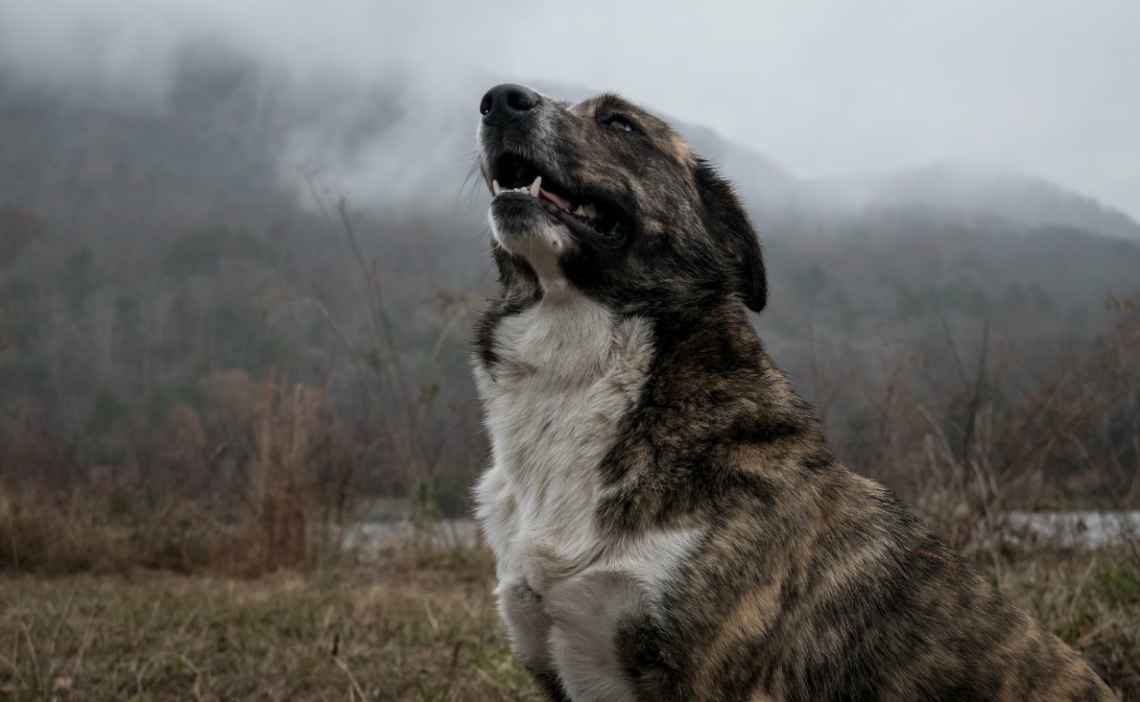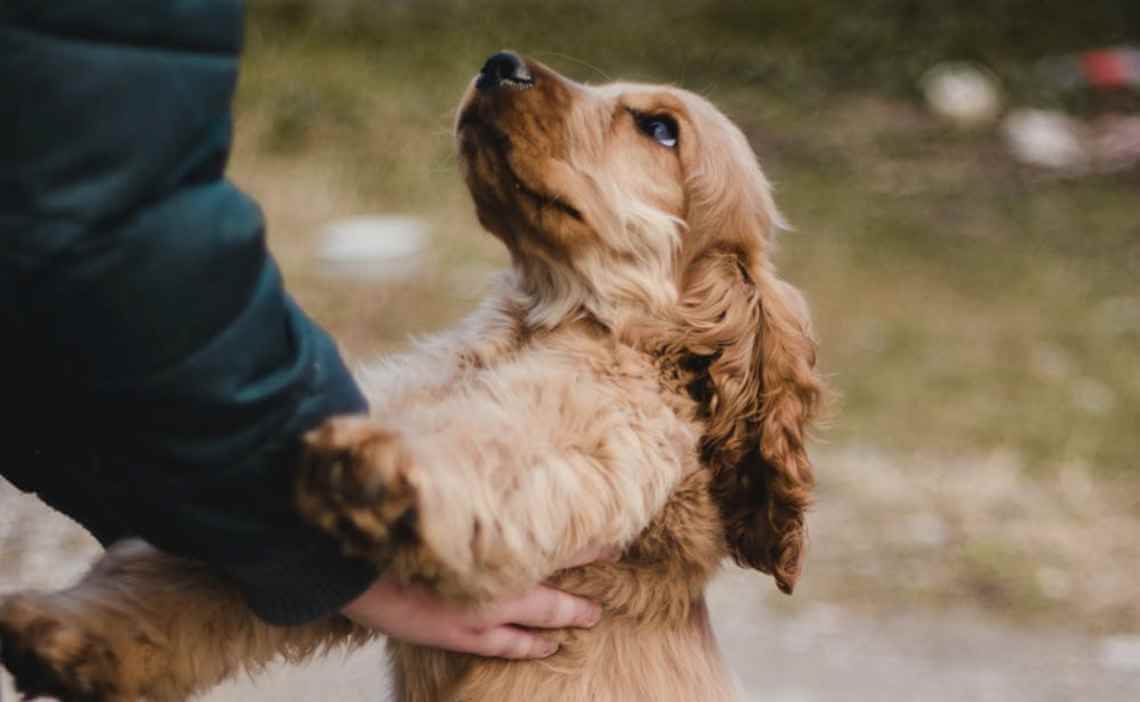
Have you ever heard a dog bark and wonder what it means? Or maybe you’ve experienced a dog growling or whimpering and thought you had a good idea of what the dog was trying to express. Dog sounds can convey important meanings; the better you are at discerning them, the better you’ll understand your furry companion.
Social species are known to be much noisier than animals that lead solitary lives. For example, snow leopards live their lives in central Asia in near silence, but groups of monkeys chatter incessantly in a high-pitched tone.
Given that dogs are descended from wolves, which are highly social animals, it’s no surprise that dogs communicate with humans, dogs and other animals using a variety of vocalizations, sounds and mannerisms.

How Dogs Speak
Dogs talk to us using their body language and different sounds, such as:
- Barking
- Growling
- Whining
- Whimpering
- Howling
- Huffing
- Grunting
- Moaning
- Yelping
- Yipping
- And other nuanced sounds.
From the earliest moments of a puppy’s life, dogs and their canine relatives produce tones, yelps and whines. Atonal barks and grunts appear within the first weeks of life in conjunction with the onset of social behavior.
Dogs have a very wide range of barks and sounds. They bark when alone and with other dogs. Some bark when playing, some when a car goes by, most when someone rings the doorbell. This is in contrast to wolves, who bark less frequently and in fewer contexts, primarily for warning or defense.

Research Behind Dog Sounds
How do we discern what canine vocalizations mean? Believe it or not, animal behaviorists have only begun researching dog vocalizations. Vocal behavior in birds and other species have been studied extensively, even to the point of note sequence and tiny variations. Vocalizations in dogs have not received comparable scrutiny. Vocal variations are a prominent feature of dogs and there is a lot to be studied.
There has been preliminary research, however. The research that has been done has been very insightful. For example, dogs use growling to accurately determine each other’s size.
Growls appear to be useful for other reasons. Dogs can distinguish between “play growls”, “stranger-approaching” growls and “food-guarding” growls. Even though food-guarding and stranger-approaching growls sound very similar to human ears, dogs are able to distinguish and act on different growls.
In the past, barking was often dismissed as meaningless noise. However, researchers are finding that barks produced in different contexts vary in their acoustic parameters (i.e. tone and pitch). For example, a stranger ringing the doorbell is a type of a “disturbance bark.” Disturbance barks are harsher and lower in pitch than “isolation” and “play” barks. Isolation (when a dog is separated from his or her owner) and play barks have a higher pitch and frequency, and a wider range of amplification modulation. A dog barking at a stranger sound very different than a dog barking before going on a walk.

Meaning Behind the Sounds
We’ve established that dog sounds can be nuanced and vary according to the context in which they are delivered. However, does that mean dog sounds carry meaning?
They do for dogs, although scientists are still exploring ways to determine exactly how they perceive and process that information.
Of course, humans can decipher different barks as well. Even if they aren’t trained to work with dogs, people are able to classify barks into their appropriate contexts and attribute them to perceived emotional states. People are able to distinguish an isolation bark as being a sad bark while barks from a play session are discernable as happy barks.
Interestingly, our ability to do this starts as early as age 10; children are able to assign different barks to the correct context. Humans are even able to so accurately discriminate between different barks that they can program computers to categorize them.

Recognizing the Patterns
How do we perceive meaning in the vocalizations of other species? Apparently, dogs and humans have more in common than you might think. Due to our shared mammalian histories, canine and human vocalizations follow similar acoustic patterns.
For example, high-pitched tones tend to convey friendliness, affiliation and “come here” whereas low-pitched tones tend to project aggression and “go away.” These rules and tendencies are shared across mammalian and avian species.

Barking
Researchers are studying the theory that dogs often bark because they feel “conflicted.” Dogs bark in so many situations that some have theorized that they are in a state of alertness or are experiencing an internal state of conflict. For example, a dog will bark when they are in the house and want to go out, and when they are out and want to go in.
Genes, environmental factors and individual temperaments all play a role in a dog’s vocalization patterns. As an example, Basenjis, a typically barkless dog, will produce one or two low “woofs” when they do actually bark. In contrast, the maximum number of barks recorded for a Cocker Spaniel in a 10-minute period was 907, or more than 90 a minute.
Individual dogs have different temperaments; some will bark profusely even if it isn’t a characteristic of their breed, and some will rarely bark even if their breed is known to be “barky”.
Take the time to pay attention to the pitch and tone of your dog’s bark as well as contextual cues. A dog that barks when you get home is probably saying they are happy to see you. A neighbor’s dog that runs along the fence, barking and snarling is telling you to stay away from her territory. You get better at interpreting a dog’s bark by observing when, where and how your dog barks as well as the body language that goes along with it.

Whining
A dog’s whine is almost as versatile as a bark, but not as assertive. Dogs normally whine when they want something – a toy, food, attention, etc. A dog that whines at the door probably wants to go out, and a dog that whines next to his leash probably wants to go on a walk.
Whining can also show anxiety or fear. A dog with separation anxiety will whine while alone and a dog that is afraid of the veterinarian will whine in the lobby. Dogs also will whine when they are in pain. If your dog seems uncomfortable and is panting and whining, that could indicate they are in pain. Look for contextual clues to let you know what your dog is trying to communicate.

Growling
Growls are pretty straightforward. Most of the time they mean “stay back,” “stop touching me,” or “I will bite you if you come closer.” Of course, dogs will growl when they are playing, especially if they want you to keep playing with them.
Besides play growls, growls are a warning that is to be respected. Dogs that are punished for growling may jump directly to biting to get their point across. We often see this in a pack setting at Canine Campus. Dogs that feel irritated, intimidated or threatened will sometimes move past the “growling” stage directly to the “protection” stage without any warning because they have been reprimanded too many times for growling.
At Canine Campus, in order to defuse some altercations, instead of scolding the dog that is growling, we will distract the dog that is being growled at in order to diffuse the situation. This way, we are allowing the growling dog to “speak its mind” safely without an altercation. Growls and snarls are intended to be intimidating. Pay attention to your dog’s growls. They could be saying “I heard something outside” or “stop touching me” or “I don’t like that dog or person and will bite if they don’t back away.”

Howling
Howling may be an ancestral trait. Wolves howl to communicate with their packs and dogs may be doing the same thing. Howling seems to be contagious among dogs, just like it is for wolves.
Some dogs never howl, and some breeds, like Siberian Huskies, howl regularly and use howling to “talk,” making strange and often amusing noises as they express joy, curiosity, frustrations and other emotions that seem totally alien to us.

Sighing and Groaning
Dogs sigh and groan to show contentment as well as disappointment. Puppies moan and groan when settling down for a nap and adult dogs may continue these vocalizations. If your dog pesters you to go out for a walk and then flops down with a loud sigh or groan, he is probably trying to show you that he will be disappointed if you don’t take him out soon.
While it is tempting, you can’t always compare human sounds with dog sounds. For example, dogs typically yawn when they are nervous, not tired, like humans. The sigh seems to be universal though – both species tends to sigh when contented, disappointed or exasperated.

The best way to understand the meaning of dog sounds is to pay attention to the context and body language of our dog to determine what is triggering the vocalization. If your dog has behavioral issues that seem to accompany the sounds, consult your veterinarian or a trained animal behaviorist to help you figure out the underlying issue and how to correct it.
What type of sounds does your dog make that makes you wonder what he or she is expressing? Please comment below…
———-
Sources:
Pongrácz, Péter, et al. “Dogs’ Expectation about Signalers’ Body Size by Virtue of Their Growls.” PLOS ONE, Public Library of Science, 15 Dec. 2010, journals.plos.org/plosone/article?id=10.1371/journal.pone.0015175.
Pongrácz, P. 2017. Modeling evolutionary changes in information transfer. Effects of domestication on the vocal communication of dogs (Canis familiaris). European Psychologist, 22:219-232. http://etologia.elte.hu/file/publikaciok/2017/Pongr%C3%A1cz%202017%20-%20Modeling%20evolutionary%20changes%20.pdf
Pongrácz, P, et al. “Barking in Family Dogs: an Ethological Approach.” Current Neurology and Neuroscience Reports., U.S. National Library of Medicine, Feb. 2010, www.ncbi.nlm.nih.gov/pubmed/19181546.
Molnar, Csaba, et al. “Do Children Understand Man’s Best Friend? Classification of Dog Barks by Pre-Adolescents and Adults.” Academia.edu, Applied Animal Behavior Science, 11 Sept. 2011, www.academia.edu/1542213/Do_children_understand_mans_best_friend_Classification_of_dog_barks_by_pre-adolescents_and_adults.
Yin, Sophia, and Brenda Mccowan. “Barking in Domestic Dogs: Context Specificity and Individual Identification.”
Journal of Personality and Social Psychology, American Psychological Association Inc., 19 June 2015, ucdavis.pure.elsevier.com/en/publications/barking-in-domestic-dogs-context-specificity-and-individual-ident.

 Does Your Dog Know You Love Him or Her? Here’s How to Tell
Does Your Dog Know You Love Him or Her? Here’s How to Tell How Service Dogs Reduce PTSD Symptoms: Unleashing the Healing Bond
How Service Dogs Reduce PTSD Symptoms: Unleashing the Healing Bond 7 Ways to Tell Your Dog You Love Them
7 Ways to Tell Your Dog You Love Them How to Introduce Your Dog to a New Baby
How to Introduce Your Dog to a New Baby Why Do Dogs Pant: Unraveling the Mystery Behind This Canine Behavior
Why Do Dogs Pant: Unraveling the Mystery Behind This Canine Behavior






My dog “mumbles” frequently like he’s talking to me when I sing to him at bedtime and other occasions. And he always sighs and relaxes his body with the last song. I fervently hope I can communicate with him in our next iterations.
He never growls, whines, howls or groans. And his barking sequences are quite distinctive, i.e., his happy bark is a low-high-medium-medium sequence. And his impatient barking sequence is quite different. He’s quite entertaining!
I am very concerned about what my 11 year old LabraDane is communicating to me starting back in November of 2019 and progressively getting much worse. That is, she moans and groans on a regular basis with the groaning becoming much more frequent and lasting for longer periods of time. Is she in pain? She has had recent x-rays and blood work and a urinalysis. There is nothing terribly remarkable.
Back in November she also had an ultrasound.
I am trying to get a good recording of the ” sounds ” but so far they last such a short period of time that it is difficult.
Any thoughts on this? I am very concerned that something is terribly wrong and that it has not been picked up.
Thanks you!
Gael Ross
I have a very vocal Maltese shitzu. We come home and he likes to jump up and down and the noises of excitement he makes sound like he is being tortured lol yapping and yapping at ear piercing volume. It is both cute annoying and deafening. The only way to stop this with visitors is to put his bark collar on (uncharged) but it settles him.
I must add he also gets alot of anxiety,whether it is car travel, storms etc
It sounds like you may need to find a qualified dog behaviorist to help with this. You can always ask your veterinarian for a local referral if you don’t know where to go. You can also as your veterinarian about the level of anxiety your dog experiences. Thank you for sharing your experience and let us know how it goes.
Our cavapoo groans/growls for quite awhile in the following situation: he has been snuggling with/sitting next to someone, always (so far) a male. When his buddy’s spouse arrives on the scene, and gets close to him/them, he begins. It is more of a groan than a growl, but it goes on and on. He definitely doesn’t sound happy, but he doesn’t snarl or show teeth, nor has he bitten. We just can’t tell if he’s talking or warning. How to handle this? Thanks.
You may want to have a consultation with a certified dog behaviorist about the situation and the best way to respond. One of the hardest parts of being a dog parent is they can’t tell us what they’re thinking. Thank you for sharing your experience with us and let us know what you find out!
When my 10 month old Pug/Rat Terrier-Shih Tzu mix is out on the patio or when we are walking, some people he will bark at and others he will not.Why is this?
Hi there! My guess would be your dog finds something threatening about some people and not others. What’s your guess? Thanks for stopping by the Canine Campus blog!
Doug, my 11 year old ChiPin, doesn’t bark, I mean he can but I’ve only heard him bark at the door (once or twice).
He groans, sighs and make a little “snuffing” sound. When he lying next to either one of us, on the recliner, he’ll sometimes roll over on his back and then the little snuffing and sigh sounds begins.
He only growls at other dogs (though cats and road runners are chase bait) and will even get aggressive but I keep him under control and will stand in between him and his trigger.
I’ve taken him to the “dog Park” and he’s very timid but will tolerate the other dogs that get next to me. He doesn’t know how to play (yet) and doesn’t like it when other dogs try to play with him. He goes into resource guarding (I’m the resource I guess….)
After 1 year of having him his personality has broken out of the shell he constructed to keep himself safe.
Adopt
Thank you for sharing your experiences with Doug!
I just rescued a 2 year old Chi/mix. He is OK when walking and in the home he’s a gem.
The one thing that is unacceptable is that he’s shy with men and he becomes VERY aggressive when a man approaches him, if he is wearing a uniform it’s an all out attack.
He was found on the street (walmart parking lot) and was very scared and wouldn’t let anyone near him. At the rescue it was 2 days before his “rescue mom” could even touch him.
He was brought by at 12:45 and by 4:00 he was in my lap.
I got on the floor and ignored him. He got curious and came over to check me out in minutes.
We’ve had him for 2 weeks and the “man attacks” are my main concern.
btw I’m starting a 6 week course on basic training. I just hope that he can hold his emotions in check so they will let us stay with the program.
It sounds like your dog might have some trauma. So glad to hear you and your rescue are attending a basic training course. Let us know how it goes!
Doug the dog in my other post was very old and we had the euthanize him on Jan. 21st.
It was a horrible last week watching him go down. We were petting him and saying affirmations as he slipped away.
The Vet was gentle, calm and professional. So a big thank you to her.
I miss Doug and I always will.
Redd is a big help.
I’m so sorry for your loss. May the memories of Doug bring you comfort during this time of loss. Thank you for sharing your experience here on the Canine Campus blog.